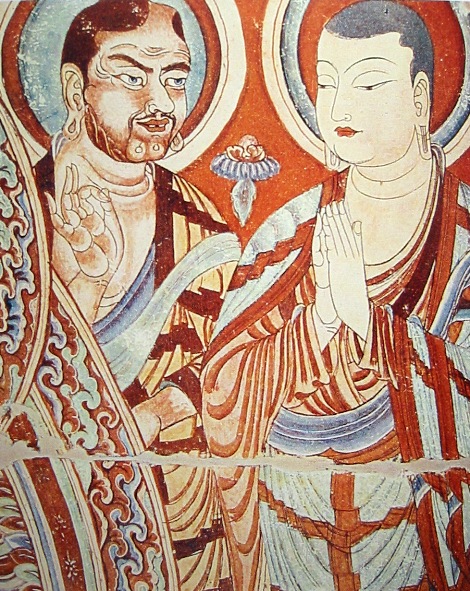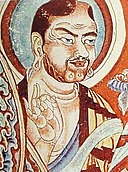Datoteka:Central Asian Buddhist Monks.jpeg
Central_Asian_Buddhist_Monks.jpeg ((470 × 591 piksela, veličina datoteke: 173 KB, <a href="/wiki/MIME" title="MIME">MIME</a> tip: image/jpeg))
| Ova je datoteka sa stranica Zajedničkog poslužitelja Zaklade Wikimedije i smiju je rabiti drugi projekti. Opis s njezine stranice s opisom datoteke prikazan je ispod. |
Sažetak
| OpisCentral Asian Buddhist Monks.jpeg |
A Caucasian Central Asian monk, possibly an Indo-European Sogdian or Tocharian, teaching an East Asian monk, perhaps a Turkic Uyghur or Chinese, on a 9th-century AD fresco from the Bezeklik Thousand Buddha Caves near Turfan, Xinjiang, China. A detail from Praņidhi scene no. 5 in Temple no. 9. The book that this painting is reproduced in has full descriptions of these two figures. Relevant details, along with the German descriptions, are found below.
In "Tafel 19" of his Chotscho: Facsimile Reproduction of Important Findings of the First Royal Prussian Expedition to Turfan in East Turkistan] (Berlin, 1913), Albert von le Coq identified the figure on the right as a "Tocharer" (i.e. Tocharian) and the figure on the left as "Ostasiate" (i.e. East Asian). In other murals of the Bezeklik Budda Caves, however, foreign-looking Caucasian men have been identified as ethnic Sogdians (an Eastern Iranian people). For instance, Scene No. 6 in Temple 9, in the same temple as the aforesaid mural, modern scholars have identified the kneeling men draped in silk robes as Sogdians (see Gasparini, Mariachiara. "A Mathematic Expression of Art: Sino-Iranian and Uighur Textile Interactions and the Turfan Textile Collection in Berlin," in Rudolf G. Wagner and Monica Juneja (eds), Transcultural Studies, Ruprecht-Karls Universität Heidelberg, No 1 (2014), pp 134-163. ISSN: 2191-6411. See also endnote #32 for further information on source material.) |
|||
| Datum |
8. stoljeće date QS:P,+750-00-00T00:00:00Z/7 |
|||
| Izvor | Chotscho: Facsimile Reproduction of Important Findings of the First Royal Prussian Expedition to Turfan in East Turkistan, Berlin, 1913. A catalogue of the findings of the Second German Turfan Expedition (1904–1905) led by Albert von Le Coq, containing colour reproductions of the murals, which were destroyed in WW2. (National Institute of Informatics – Digital Silk Road Project Digital Archive of Toyo Bunko Rare Books) | |||
| Autor | of the paintings - Unknown. Of the book, Albert von Le Coq. | |||
| Ostale inačice |
|
|
This is a faithful photographic reproduction of a two-dimensional, public domain work of art. The work of art itself is in the public domain for the following reason:
The official position taken by the Wikimedia Foundation is that "faithful reproductions of two-dimensional public domain works of art are public domain".
This photographic reproduction is therefore also considered to be in the public domain in the United States. In other jurisdictions, re-use of this content may be restricted; see Reuse of PD-Art photographs for details. | |||||
Opisi
Predmeti prikazani u ovoj datoteci
motiv
Bezeklik Thousand Buddha Caves engleski
image/jpeg
checksum engleski
aaf4cdb8e0a943c0225b0399ded696d3f998ed4c
data size engleski
177.252 Bajt
591 točka
470 točka
Povijest datoteke
Kliknite na datum/vrijeme kako biste vidjeli datoteku kakva je tada bila.
| Datum/Vrijeme | Minijatura | Dimenzije | Suradnik | Komentar | |
|---|---|---|---|---|---|
| sadašnja | 12:25, 27. ožujka 2005. |  | 470 × 591 (173 KB) | Beta m common | 9th century fresco from Bezeklilk, Tarim Basin. {{PD-art}} |
Poveznice
Metapodatci
Ova datoteka sadržava dodatne podatke koje je vjerojatno dodala digitalna kamera ili skener u procesu snimanja odnosno digitalizacije. Ako je datoteka mijenjana, podatci možda nisu u skladu sa stvarnim stanjem.
| Proizvođač kamere | Canon |
|---|---|
| Model kamere | Canon PowerShot S110 |
| Ekspozicija | 1/80 sekunda (0,0125) |
| F broj dijafragme | f/2,8 |
| Datum i vrijeme slikanja | 16:46, 2. siječnja 2005. |
| Žarišna duljina leće | 5,40625 mm |
| Datum posljednje promjene datoteke | 16:46, 2. siječnja 2005. |
| Razmještaj komponenata Y i C | Centrirano |
| Inačica Exifa | 2.1 |
| Datum i vrijeme digitalizacije | 16:46, 2. siječnja 2005. |
| Dubina boje poslije sažimanja | 3 |
| Brzina zatvarača | 6,3125 |
| Otvor | 2,96875 |
| Kompenzacija ekspozicije | 0 |
| Minimalni broj dijafragme | 2,9708557128906 APEX (f/2,8) |
| Udaljenost do objekta | 0,158 metara |
| Režim mjerača vremena | Matrični |
| Bljeskalica | Bez upotrebe bljeskalice |
| Kolor prostor | sRGB |
| Vodoravna razlučivost žarišne ravnine | 7.766,9902912621 |
| Okomita razlučivost žarišne ravnine | 7.741,935483871 |
| Jedinica razlučivosti žarišne ravnine | inči |
| Tip senzora | Jednokristalni matrični senzor |

